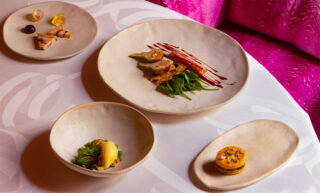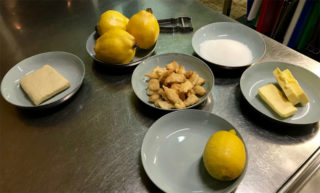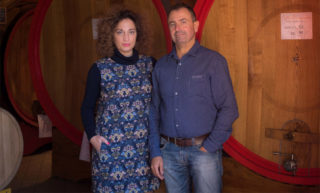Chef Emanuele Scarello is the hero of the humble potato
The publicity bombardment generated by the list of the 50 (currently 120) supposedly best restaurants in the world, tends to obscure the merits of other restaurants that perform at a very high level.
Two-starred Agli Amici in Godia near Udine in Italy’s northeastern province of Friuli is one of them. In the shadow of rock star Ana Roš’s nearby Hiša Franko, the siblings Michela (sommelier, host) and Emanuele (chef) Scarello are quietly but steadily delivering an exceptional dining experience. Regionality is the main trait. Along the way, Emanuele Scarello has become the hero of the humble potato.
Mitteleuropa
The village of Godia, now a suburb of Udine, is unassuming, but the surrounding landscape is spectacular. Like a stage curtain, a row of low mountains rising up from the flat land near Godia only partly conceals the majestic snow-capped mountains of the Julian Alps. The rich fishing grounds of the Adriatic are just a 45-minute drive south and westbound the former republic of Venice that dominated the Mediterranean trade routes is only an hour and a half away. Slovenia and Central Europe are almost literally around the corner. There you have it, the ingredients for Scarello’s kitchen, utterly regional, but with many different influences. Or, as Scarello says: “I am Mediterranean, but with roots in Mitteleuropa. I love all cuisines as long as one cooks with passion.” (He used the German word for Central Europe in a conversation held in Italian.)
Hallmarks
Scarello’s passion is obvious. He is friendly, polite and soft-spoken, but his words carry the weight of many years in the kitchen. Asked how he would describe his cuisine, he says he has never thought about that. “I just do it”. His highest aim is to bring out the best flavour of any product. “Ninety per cent comes from Friuli,” he says. “I want my cooking to be true, sincere and transparent. It has to tell the story of the people and the territory. For me San Daniele ham and the potato are the hallmarks of my region.”
The potato, it isn’t the first product that springs to mind when you think of Italy.
Where pasta of durum wheat (grano duro) is the main source of carbohydrates in southern Italy, and a richer version with egg yolks in Emilia-Romagna, rice takes center stage in the north. Around Udine, however, the potato found its home.
Kennebec
The history of the potatoes in Europe goes back to the sixteenth century when the Spanish imported them from their forays into South America. Until then the most important source of carbohydrates were grains. In northern Europe rye was the main staple; wheat was grown further south. As rye is harder to digest and can’t rise without adding more refined and more expensive wheat, the potato quickly became a welcome alternative on the daily menu in northerly regions. Southern parts followed later. Around Godia potatoes weren’t introduced until a century ago. The well-draining, pebble-rich soil, deposited by the river Torre, made the area feasible for production and after some experimentation Kennebec eventually became the dominant variety. This relatively starchy and floury American hybrid turned out to be perfect to make gnocchi. And so Scarello made the potato into one if his key ingredients, not only for his gnocchi in the Kitchen Bar next door, but also for several dishes in the fine dining restaurant.
Sensibilità and artigianalità
If you have read Pellegrino Artusi’s groundbreaking cookbook ‘The Science of Cooking and the Art of Eating Well’, you may know gnocchi come in several varieties: corn, semolina and wheat. But Scarello’s are the real ones, the potato gnocchi. He explains how he makes them: The unpeeled potatoes are cooked for 20 minutes at 170 °C in a steamer. After that the steam is allowed to escape and the potatoes to cook dry for a further 30 minutes at 180 °C. Doing so they loose water. The potatoes are then peeled and pressed when they are still hot. Subsequently, the puree is lightly mixed with egg yolk and minimal flour, before being spread out on the counter to cool off.
The drier the cooked potato, the smaller the amount of flour you need. Scarello: “The secret is to use as little as possible. It is sensibilità [sensitivity or Fingerspitzengefühl].”
The last step is to create the little dumplings. The ones for the gnocchi bar remain smooth; those for the gourmet restaurant get a more labour-intensive ridged surface for the sauce to stick even better. With due pride Scarello calls them a work of artigianalità or craftmanship.
As Scarello doesn’t want anything to go to waste, he uses the potato peels for his amuse. Dried in the oven at 160 °C, the crispy peels are then brewed in hot, salted water for seven minutes to create a delicious, clear and concentrated broth with the flavour of roasted potato. Served with a rustic but elegant sprig of rosemary, it prepped our stomachs for the nine-course dinner that followed.
Broth of potato peels
Verdura povera and acidity
Traditionally potatoes are a verdura povera, a poor man’s vegetable, but at Agli Amici they are fine dining material. Although potatoes (in whatever shape) feature most prominently as primi (as gnocchi or in a pea soup with its pods and scallops), they also show up among the main courses (secondi). Last season, for instance, Scarello served a floral potato salad consisting of eight different varieties, ranging from the French La Ratte to the purple Vitelotte, dressed with jellified vinegar and fiore di sambuco (elderflower).
Scarello not only investigates the endless possibilities of the verdura povera, he also tries out different types of acidities to brighten up the starchy tuber or the gnocchi. Lemon is the obvious source of acidity in a Mediterranean country, but over time he shifted to vinegars and now also uses tamarind, which can add a touch of date-like richness when ripe.
Potato spaghetti
Inspired by Gualtiero Marchesi, one of Scarello’s culinary heroes and the first Italian chef to receive three Michelin stars, Scarello also developed a dish for which he finely slices the potato as if it were spaghetti. He then serves it with chives, black caviar and shaved bottarga (traditional, but highly effective) or with cream and powdered mushroom. Gualtiero Marchesi almost single-handedly lifted the Italian culinary scene from osteria-style cooking (or Sunday family meal cooking, as Scarello called it) to fine dining. His riso, oro e zafferano, a risotto alla milanese with gold is epic. Just like Marchesi, Scarello’s parents ran a restaurant, which he eventually took over.
La mamma
Before taking the helm in the family restaurant in Godia, Scarello went to the local Arta Terme culinary school in Udine and the Ecole du Gran Chocholat in Tain l’Hermitage (the home town of Valrhona chocolate) after which he embarked upon engagements in France, Austria and Spain. When asked, Scarello doesn’t want to disclose at which restaurants he worked abroad. They wouldn’t reflect his current style, he says.
Marchesi aside, his other big example is Massimo Bottura for bringing modern Italian cuisine to the rest of the world. His ultimate hero, however, is la mamma. Who else? Together with her Scarello earned Agli Amici’s first star. He admires his mother not only for her technique and sophisticated taste – she went to Gaston Lenôtre’s culinary school in Paris –, but also for imbuing him with sensibilità…
Hare’s blood
It wouldn’t do Scarello justice to portray him as the hero of the humble potato only. His repertoire is much broader. The nearby Adriatic Sea allows him to shine with fish and crustaceans. Among other things, he served us sole layered with herbs and a fiery touch of horseradish, a nod to Udine’s history as a part of Habsburgian Mitteleuropa, the culinary heritage of which he absorbed when he worked in Vienna. The heat of the horseradish may seem unusual with fish, but done sparingly it lifts up the dish.
Marco Polo made his entrance through the curry ravioli in which the briny-sweet lobster and the sweetish notes of the squash bisque neatly balanced the spices. Our main course was a tribute to Paul Bocuse: lièvre à la royale. Where the local, rustic version of hare is simmered in red wine and served with potatoes, Scarello’s creation came with a sophisticated reduction of the hare’s blood, concord grapes and a sauce of goose liver and the juice of indigenous picolit grapes, a understandable choice given that those are also used to make sweet wines.
Structured wines
Agli Amici boasts a cellar of seven thousand bottles of wine, the realm of sommelier and host Michela Scarello. She phased out the new world to create more focus in the collection. The emphasis is on Friuli, but there are many good options from the rest of Italy and the most important European regions. On its famous ponca soils (marl and sandstone with marine sediments), Friuli grows a range of grape varieties. The best known wines are the minerally Pinot Grigios from the Colli Orientali DOC, but the wines from indigenous varieties, such as ribolla gialla, picolit, friulano, schiopettino and pignolo steal the show nowadays. Perhaps more than through food, the connection with Slovenia is through wine. Producers like Gravner, Radikon and Simčič literally work on the border and provide beautiful skin fremented white wines, so characteristic for the area. These structured wines are often considered to pair well with food, and the Le Due Terre blend of ribolla and friulano we drank was no exception. But the highlight was Gravner’s 2004 Pignolo: tannic and quite full-bodied, yet fresh and elegant, it hadn’t lost its lively primary fruit aromas. More than a decade of maturation in barrel and bottle made the wine very approachable.
Embedded in the region
In a globalizing world in which restaurant concepts are often geographically completely interchangeable, Agli Amici is firmly embedded in its region, even when Scarello plays out a couple of international twists. The transformation of the potato from an unpretentious ingredient that primarily fills your stomach into a gastronomical delight is just one of his achievements that deserves to be pulled out of the shadow into the limelight.
Agli Amici
Via Liguria 252
33100 Udine (Italy)
T: +39 0432 565411
A version of this article was published (in Norwegian) in the July 2020 issue (print) of Apéritif magazine.







Comments